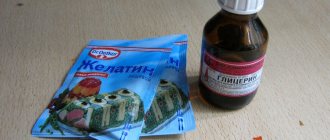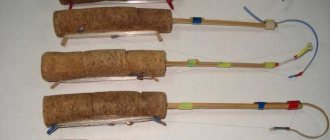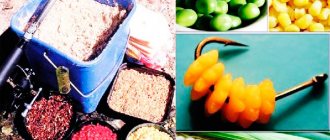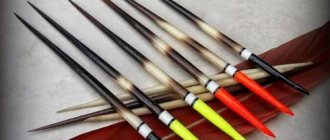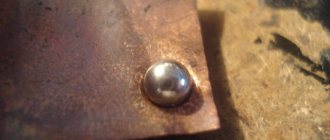Every angler has had troubles associated with spinning rod breakdowns, whatever one may say, but there are no eternal rods, sooner or later breakdowns happen.
Due to the complexity of manufacturing a modern spinning rod, it contains many structural elements that can break. Even the simplest fishing rod has guides, a handle and a flexible tip that are subject to wear. Not to mention the body of the rod itself, which suffers from improper transportation, damage from heavy objects and improper use.
There are several common breakdowns that you can fix yourself. It is not always possible to do this in fishing conditions, but you can improve the condition of the gear if you have some tools and materials.
Common spinning rod breakdowns:
- Fracture or damage to the tip.
- Damage to the guide rings.
- Damage to the rod knee.
- Damage to the rod handle.
Fracture of the tip in the middle
The fracture of the tip of the spinning rod in the middle is carried out by merging two halves. This also has its own nuances, because there are 2 types of tops, hollow inside and monolithic.
Hollow, just insert into the middle a sewing needle of a suitable diameter or a piece of rigid wire, thoroughly lubricated with epoxy resin or epoxy-based glue. You need to let it dry and rewind it tightly with a thin nylon thread, covering it with varnish for rigidity. Such a rod will firmly hold its shape, and the external winding will not allow the tip to break again.
Monolithic ones have a slightly different repair principle; you need to select a thin-walled metal tube; a piece of an old radio antenna works well. You need to degrease the broken parts, lubricate them with epoxy resin and insert the tube into the prepared piece so that both halves meet inside. If you leave a void there, most likely such a connection will simply break at the first load. You also need to varnish the entire connection and wrap it tightly with a thin nylon thread, cover it with a second layer of varnish on top and let it dry.
Fracture at the base and tip
Tops with a fracture at the base and at the tip are repaired with minimal noticeability, since it involves removing the broken part.
If the tip with the ring is broken off, then you need to heat the remains of the tip in the seat of the ring with a lighter, after which they can be easily removed. On the remaining part of the tip, the tip is cut off and leveled with a sharp knife, the diameter is approximately adjusted for the seat using sandpaper. Then it is mounted with epoxy resin, the end ring on the tip.
In case of a fracture at the base, you must also remove the ring from the top. Remove the plug at the base of the telescopic spinning rod and push the remains of the broken part of the top into the inside of the spinning rod. This way the residue will fall out at the bottom of the rod. For most of the broken top, you need to cut off all the irregularities in the area of the fracture and create a smooth, thick edge. Then apply a strip of varnish or epoxy resin, about one centimeter wide, to the tip of the thick edge of the tip. Using a thin nylon thread, wind 8-10 turns, carefully trim and apply varnish on top of the thread. This way we compensate for the thickness of the lost part of the tip, because it has a very inconspicuous conical shape. After the varnish has dried, you need to remove irregularities around the circumference of the turns using fine sandpaper. Then the tip needs to be pushed through the bottom of the spinning rod, in the reverse order as we removed the remaining debris. In the end, we get a slightly shortened tip that does not lose the functionality of folding with the rest of the spinning rod’s legs. Having placed the final passage ring on the glue, the repair can be considered complete.
Damage to the guide rings
The breakdown is not critical, but unpleasant; in most cases, the guide rings simply peel off from the knees of the spinning rod. This problem can be solved either by applying a layer of epoxy resin and shrinking the pass ring over the entire place, or by rewinding it with a nylon thread and applying a layer of varnish.
If the ring is destroyed, missing, or the ceramic liner has disintegrated, most likely such repairs will end with selecting a ring of the required diameter in a fishing store and replacing it with a new one.
Repair of a composite knee of a spinning rod
Fractures of composite rod knees are critical in most cases. They are restored using a metal sleeve, where the two broken parts need to be trimmed evenly, removing all signs of a fracture, and placed on epoxy resin, connected with a metal sleeve. Additionally, such a connection is varnished, wrapped in several layers of nylon thread and covered, for a durable connection, with a second layer of varnish or epoxy resin.
Also, if the fracture is in the middle of the knee, you can organize the connection as an integral part of the spinning rod. Thus, a broken leg in half will look like 2 composite rod legs. The connection is not difficult; just select two metal bushings that fit tightly into each other. Then adjust both broken parts to the diameter of the bushings and use epoxy resin to seat the bushings on both halves. Such tackle practically does not lose its structure, in places where the bushings shrink, you can also further strengthen the connection by winding nylon thread with a varnish coating.
Spinning reel repair
A modern spinning reel is a complex and simple mechanism at the same time. It is, however, not difficult to sort through it if necessary and if you have some experience. If you are doing this for the first time, it will take you longer, but in this situation, difficulties usually do not arise. diagram of the structure of your reel model on hand or photograph each assembly before disassembling it. Otherwise, the chances of assembling the inertia-free system correctly are slim.
This should be done if the movement of the line laying machine has become difficult, it is difficult to reset to the working position, or the clutch has begun to work poorly. Most often the reason is sand, which gets inside and mixes with the lubricant. To minimize the likelihood of this problem, try to never place your tackle on the ground when fishing from shore. Thanks to this basic precaution, they will serve you much longer.
In many cases, a simple overhaul and replacement of lubricant is enough to return the mechanism to normal operation. If the situation is more complex, and replacement of one or more parts , it is worth answering the question about the feasibility of such repairs. In the case of an inexpensive reel, it is worth carrying out only if the new parts are cheap or you can make them yourself - for example, bend a line handler arm from a wire of a suitable diameter to replace the old one.
Thus, if the gear fails, it is not necessary to buy a new one. A breakdown of a spinning rod can often be fixed on your own, bringing it back to life - this applies to both the rod and the reel. Which of these two options to choose is up to you. You should not discount repairs in the workshop, especially if we are talking about high-quality gear - a good specialist will always be able to do the necessary work in the best possible way.
Repair of the telescopic knee of a spinning rod
In most failures, the telescopic knee is severely damaged, accompanied by longitudinal cracks on a fairly large surface of the knee. The best solution would be to buy a suitable elbow from a fishing store, adjust it to the size of the spinning rod and replace it.
But some damage can still be repaired, it all depends on the characteristics of the damage.
Crushed knees, accompanied by small cracks, are easily restored. If there is deformation at the site of damage, this often happens if you carelessly place a heavy object on the rod. In this case, you need to heat the damaged area with a hairdryer and try to straighten the flattened area. Then cover the damaged area with a small layer of epoxy resin and wrap it with a slight tension, but in tight turns, with a nylon thread. Next, you need to re-apply epoxy to the thread and, as necessary, add a number of more turns of nylon thread. After drying, such a connection becomes very durable and allows you to keep your favorite gear in service.
Fractures of the knees of a telescopic rod can be repaired using external and internal reinforcement. You can use a piece of a telescopic rod from an old tackle, suitable in diameter, using it in the form of a rod inside the knee, or the outer frame of the broken halves. This joint is installed on epoxy resin. It is strengthened by rewinding dense turns of nylon thread and applying epoxy resin or varnish on top.
Do-it-yourself repair of a broken spinning rod
If a breakdown is detected, you should not immediately take action. Repairing a spinning rod with your own hands is a serious matter. Therefore, you first need to carefully examine the breakdown and think carefully about what can be done in this particular case. There will definitely be a way out.
Rearranging the tulip
Breakage of the tip at the very base of the tulip
easy to fix. You should clean the broken end and move the tulip to a new place.
To free the tulip tube from the broken tip, you need to heat it. Next, estimate the difference in diameter of the tube and the new seat. The difference in this case will not exceed fractions of a millimeter.
By sharpening the inside of the ring with a file, you can equalize the diameters and insert the tulip into a new place, having previously lubricated the joint surfaces with glue. “Moment” or “super cement” is quite suitable for this.
The spinning rod will become shorter by 1.5 cm - 2 cm and its test indicators will slightly increase, but this is not a reason to throw away something that can please you with good catches for a long time.
Replacing the pass ring
To replace a broken pass ring, you need to carefully melt the coating and remove the braid. You'll have to buy a new ring. Then wrap the ring with a strong cord, glue the place where it was tied, and apply several turns of electrical tape to be sure.
Before purchasing a new ring, you can use the spinning rod without this broken part.
Knee repair
If one of the spinning rod's knees breaks, you should, if possible, find out the possibility of purchasing this knee for an inexpensive payment. Some companies provide this type of service.
If this is not possible, then you will have to select a suitable insertion rod to connect the broken parts (photo 1.1). Their ends are cleaned, the rod is lubricated with glue and inserted into the internal cavities (photo 1.2). After this, the fracture site is wrapped with electrical tape or fiberglass with epoxy resin, and after drying the spinning rod is ready for use again (photo 1.3).
We present to you a short video on how to repair a spinning rod with your own hands.
This article will tell you a lot of interesting things about luminous floats for night fishing. In this article you will learn about the best holders for spinning tackle.
Top repair
A broken tip is the worst case of a breakdown, but it is not fatal if you handle the repair of the spinning rod tip with your own hands wisely. The most important thing for this is to find the right materials for the internal and external inserts.
An ideal option for an external coupling would be part of a telescopic antenna.
With the internal insert the situation is worse. Not everyone has a broken fishing rod in their house, but you can buy a rod from it. At worst - the toughest quivertype for the feeder.
Photo 2.
Photo 2 clearly shows the entire repair process. Photo 2.1 - broken tip. Photo 2.2 - materials for inserts. At the top there is an internal insert, at the bottom there is an external one. The ratio of their lengths is 1:3.
Damage to the rod handle
The handles of spinning rods are usually made in the form of hollow attachments made of cork, synthetic material based on polypropylene, dense foam or foam rubber.
Damage to handles can be different - wear, cracks, mechanical damage. Repairing such handles is quite easy.
Cork handles can be repaired using wine or champagne corks. You need to grind the wine cork into small crumbs, prepare a little waterproof acrylic glue, mix the crumbs with glue and fill the damaged areas with this mixture using the putty method. After the glue has hardened, the repaired area must be sanded, forming a smooth overall structure of the handle.
For polypropylene handles, a hardware store can find round insulation for water pipes that is suitable in diameter. You need to cut a piece of insulation to size and simply replace the damaged section of the handle.
In any case, if you really want to, you can repair the spinning rod using improvised means. But almost all parts of many spinning rod models are available in fishing stores. And in some cases, it’s still not worth inventing a sophisticated repair method by simply replacing the broken part.
Spinning - selection, operation and repair | Shcherbakov brothers
Spinning - selection, operation and repair of spinning rods (Issue 15) you can watch a video about the fishing of the Shcherbakov brothers online in good quality on our website.
Enjoy watching! Spinning rods: selection, operation, repair of a spinning rod. This will be discussed in the video about the fishing of the Shcherbakov brothers. A very important aspect in the video will be about the secrets of spinning rods.
You will learn more in this video by the Shcherbakov brothers:
— Selection of spinning rods (how to choose the right spinning rod)
— External inspection of the spinning rod when purchasing (what you need to look at when inspecting a spinning rod)
— Wall thickness of the spinning rod (dependence of wall thickness on the sensitivity and strength of the spinning rod)
— Passing rings (Importance of this element in spinning)
— Knee connection (the best options)
— Spinning rod handle (choosing the correct and comfortable rod handle)
— Reel seat (a short story about it)
— Balancing the spinning rod (An important point when choosing and using a spinning rod)
— Operation of a spinning rod (how to use a spinning rod correctly so that it lasts for a long time)
— Replacing a tulip on a spinning rod (repairing a frequently failing element in a fishing rod)
— Handle care (method of keeping the handle in beautiful condition after long-term use)
Source


